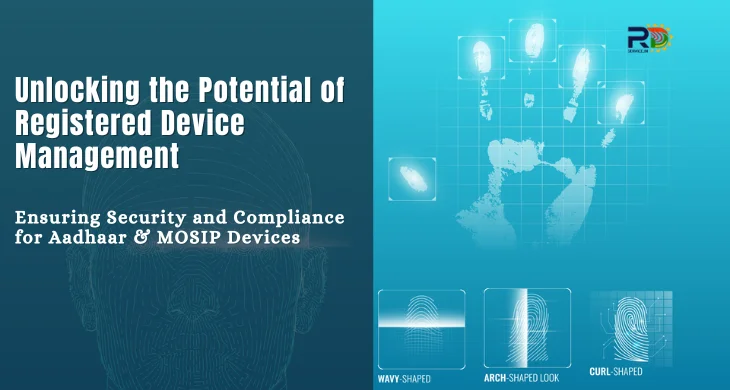
Unlocking the Potential of Registered Device Management: Ensuring Security and Compliance for Aadhaar & MOSIP Devices
In an era where national identity management platforms like Aadhaar and MOSIP play a pivotal role, ensuring the security and compliance of registered devices is paramount. Introducing our Registered Device Management (RDM) Platform – a comprehensive, fully managed solution designed to meet the unique needs of L0 and L1 compliant devices.
RDM Platform boasts a wealth of features aimed at simplifying device management, maximizing availability, and enhancing security. Let's explore its capabilities:
Administration Portal: A customizable portal allows for role-based management of devices, cost monitoring, and administration of registered device activities.
Secure API Integrations: These platform facilitates safer API integrations with devices, adhering to UIDAI specifications.
Device Key Management: Manage device encryption keys securely through Hardware Security Modules (HSM).
Telemetry Data Monitoring: Gain insights into device performance and telemetry data through our management server.
Device Application Change Management: Ensure compliance with UIDAI guidelines for device application changes.
Device SDK Support: With support for multiple platforms and technical assistance for integration, developers can streamline the process.
APIs for Device Registration: Facilitate device registration and deregistration processes through APIs.
Robust Firmware Security: THe SaaS-based model ensures secure signing, encryption, and maintenance of firmware for L1 devices, with signing keys stored in physical HSM.
Chip Provisioning: Chip provisioning services for L1 devices include chip identity generation and firmware personalization.
Seamless Upgrades: Tight integration with L1 devices ensures seamless field upgrades.
Chip Mastering: Services for chip manufacturers include firmware personalization and unique chip identity generation.
The advantages of RDM Platform are abundant:
- Simplified Device Management: Faster registration, deregistration, software upgrades, and key rotation.
- High Availability: A highly available service architecture with full DR capability.
- Affordable Pricing Model: Flexible pricing options to suit your needs.
- Multiple Device Onboarding Options: Onboard devices using various methods, mapped to specific customers for telemetry.
- In-Built Compliance: Compliant with FIPS 140-2 Level 3 standard, with regular security audits.
- Device Manufacturing Support: Provision L1 device identity during manufacturing.
- Reliable Technical Support: Customized support throughout integration and beyond.
With a track record of supporting millions of devices and successful testing with MOSIP registered devices, our RDM Platform is ready to meet your needs. Implementable with minimal turnaround time and options for private cloud setup, it's the solution you've been searching for. Reach out to us today and unlock the full potential of registered device management.
Frequently Asked Questions
What is digital identity verification?
Digital identity verification is the process of confirming an individual's identity online to ensure that the person engaging in an online transaction or service is genuinely who they claim to be. It helps enhance online security, prevent identity fraud, and ensure compliance with regulatory requirements.
How does identity verification differ from identity authentication?
Identity verification confirms a user's identity during onboarding or account creation, ensuring it matches a real-world identity. Identity authentication, on the other hand, occurs each time access to a service is attempted, ensuring the person accessing the account is the same one verified earlier.
What are the key steps in the digital identity verification process?
Collection of personal information
Document verification
Biometric verification
Data validation
Liveness detection
How does biometric verification enhance digital identity verification?
Unique physical characteristics like fingerprints, face features, and iris scans are used in biometric verification to confirm identification. It is harder to forge, includes live detection features, and offers rapid, convenient, and non-intrusive verification.